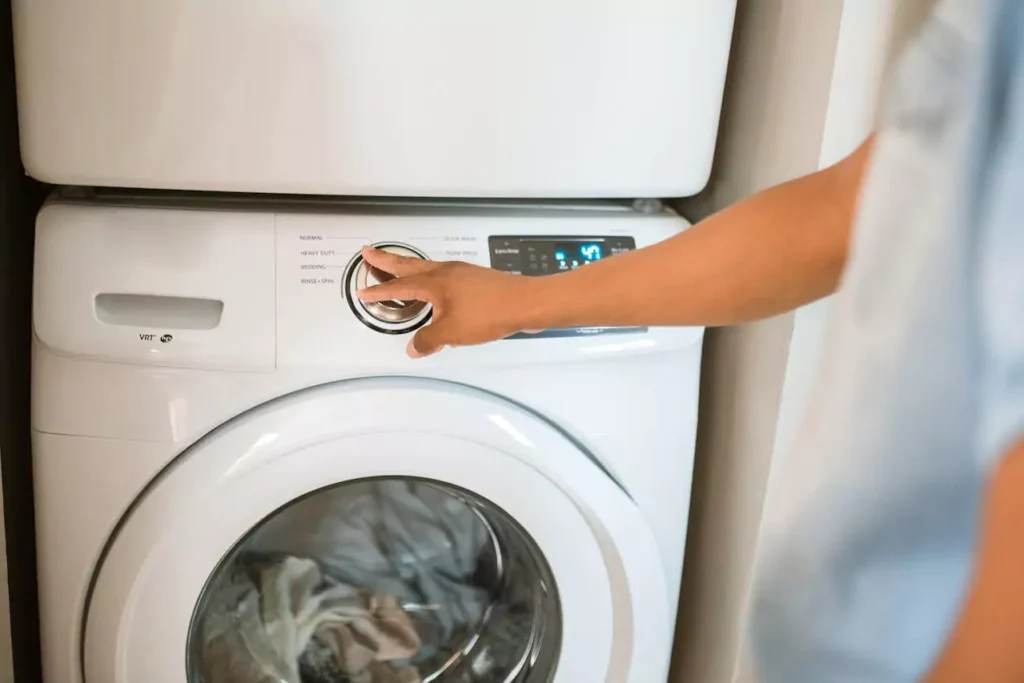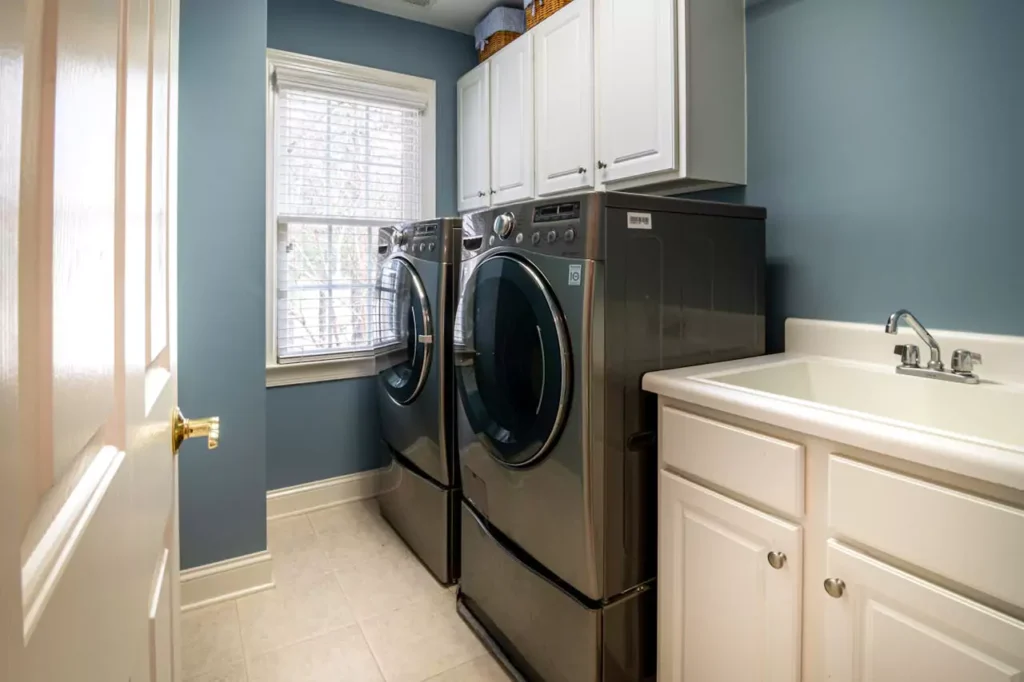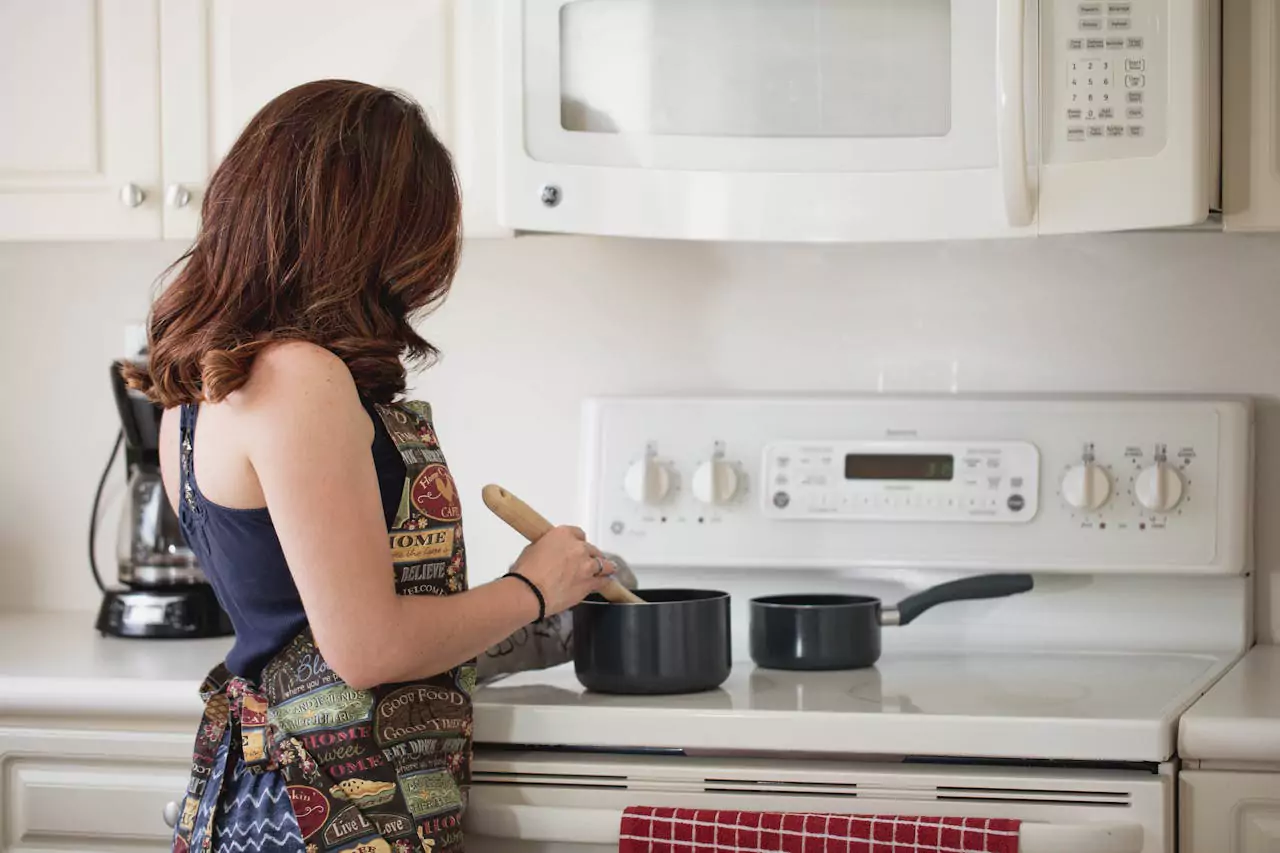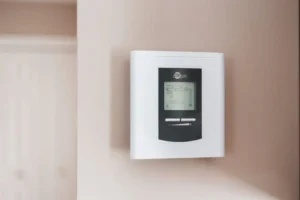Now Reading: Washer or Dryer on Top? Best Way to Stack Them
- 01
Washer or Dryer on Top? Best Way to Stack Them
- Home
- Home Appliances
- Laundry & Cleaning
- Washer or Dryer on Top? Best Way to Stack Them
Washer or Dryer on Top? Best Way to Stack Them
![]() Anne MaddisonLaundry & Cleaning, Home AppliancesAugust 3, 2025152 Views
Anne MaddisonLaundry & Cleaning, Home AppliancesAugust 3, 2025152 Views

If you don’t have a lot of space at home, stacking your washer and dryer can be a smart solution. Many people with small laundry rooms, closets, or apartments use this setup to save floor space and keep things organized. Instead of placing both machines side by side, you simply stack one on top of the other.
But when it comes to stacking, a common question comes up: should the washer go on top, or should it be the dryer? It might seem like either way would work, but there is actually a correct and safe method. Choosing the wrong setup can lead to damage or safety issues.
Stacking laundry machines the right way is not just about saving space. It affects how stable your machines are, how easy they are to use, and how long they last. If it is done incorrectly, you might face problems like water leaks, shaking, or even tipping.
In this guide, you will learn everything you need to know. We will cover which machine should go on top, which models are stackable, how to do it safely, and tips to make it work well in your home.
Can You Stack Any Washer and Dryer?
Not every washer and dryer can be stacked. Some models are made to be placed side by side only. To stack your machines, they need to be labeled as stackable. Stackable units are designed to fit safely on top of each other, often with the help of a special stacking kit.
The most common type of stackable machines are front-loaders. These have doors on the front, which makes them easy to use when stacked. Top-loading washers, on the other hand, are not stackable. That’s because you can’t open the top lid if there’s another machine sitting above it.
Before stacking, you’ll need to check if both the washer and dryer are compatible. The same brand and model series usually stack best together. Many manufacturers sell stacking kits, which are frames or brackets that help keep the top machine stable and prevent movement during cycles.
You’ll also need to make sure your space meets the basic setup requirements. These include a proper water supply for the washer, a 240-volt outlet for the dryer (if electric), and a safe way to vent out hot air, especially for vented dryers. If your dryer is ventless, this part is easier.
In short, not all washers and dryers can be stacked. Check for compatibility, get the right tools, and make sure your laundry space has everything you need before setting them up.
Washer on Bottom, Dryer on Top: Why It’s Standard
If you’ve ever looked at stacked laundry machines, you’ll notice that the washer is almost always on the bottom and the dryer goes on top. There are a few good reasons for this setup, and it mostly comes down to weight, movement, and safety.
Washers are much heavier than dryers. This is because washers have a large drum, a motor, and they fill up with water during every cycle. A full load of laundry with water can weigh a lot. That’s why it needs to sit on the floor, where it has the most support.
Washers also create more vibration while running. During the spin cycle, the drum moves quickly to remove water from clothes. If a washer was placed on top, all that movement could make the stack unstable and dangerous. Putting the washer on the bottom helps keep everything steady and prevents tipping or shifting.
Dryers are lighter and don’t move as much. They simply tumble clothes while blowing warm air through the drum. That makes them much easier to lift and safer to place above another appliance. Most stacking kits are also designed to hold the lighter dryer on top of a sturdy washer.
In fact, most manufacturers design stackable models with this layout in mind. The controls are often placed at the front and lower down so you can easily reach them when the dryer is up high. Unless your machines are built as a single unit or all-in-one combo, this washer-on-bottom setup is the safest and most reliable option.
What Happens If You Put the Washer on Top?
Putting the washer on top of the dryer might seem like an easy way to save space, but it’s almost never recommended. In most cases, doing this can lead to serious safety and performance problems.
Washers are heavy, especially when full of water and clothes. If you place one on top of a dryer, it can cause the entire stack to become unstable and shaky. Washers also move a lot during the spin cycle. All that motion puts stress on the dryer below and increases the risk of tipping or shifting.
Another issue is the plumbing and water lines. Most water hookups are closer to the floor, where the washer is normally placed. If the washer is on top, it stretches the water hoses and drainage lines, which could lead to leaks or damage over time.
There’s also the problem of control access. Most washers have controls on the front, and placing the machine too high could make it hard to reach or operate safely. Many manufacturers clearly warn against stacking a washer on top in the user manual. Ignoring these instructions may void your warranty or even cause injury.
In very rare cases, people use custom-built platforms or support frames, but these setups must be professionally designed and installed. For most homes, sticking to the standard layout is the safest and smartest choice.
| Pros of stacked washer & dryer | Cons of stacked washer & dryer |
|---|---|
| Saves floor space, which is ideal for small homes or apartments. | Can be hard to access the top unit if you’re shorter or have limited mobility. |
| Fits well in small laundry rooms or closet spaces. | The control panel on the top unit may be hard to see or reach. |
| Offers a cleaner and more organized vertical layout. | The dryer vent may need to be extended or repositioned. |
| Front-load machines can be stacked or placed side-by-side for flexibility. | You need compatible units and a stacking kit to stack them safely. |
How to Properly Stack Washer and Dryer
Stacking your washer and dryer can help save a lot of space, but it’s important to do it safely. Here’s a simple step-by-step guide to help you stack them the right way:
- Check if your units are stackable
Not all washers and dryers are designed to be stacked. Look at your user manual or product details to confirm they’re compatible. Both units should be front-loading and made to handle vertical stacking.
- Buy the correct stacking kit
It’s best to use a stacking kit made by the same brand as your washer and dryer. These kits include brackets or supports that safely secure the dryer on top. If your brand doesn’t offer one, there are also universal stacking kits on Amazon that work well and provide safe support.
- Place the washer on the bottom
The washer is heavier and vibrates more during use, so it must be on the bottom. Make sure it sits on a flat, level surface. Use a level tool to double-check.
- Install the stacking kit
Follow the instructions in the stacking kit carefully. Usually, this involves placing rubber pads or brackets on top of the washer, then lifting and securing the dryer on top. This may require two people.
- Connect all hoses and vents
Plug in the power cords, connect the water hoses to the washer, and attach the dryer vent. Make sure everything is tight and leak-free.
Not sure if stacking is right for you? Learn the key differences between combo units and separate washers and dryers to help you choose what fits your home best.
Tips for Safe and Easy Use of Stacked Units
Stacked washer and dryer units are great for saving space, but you need to use them safely and correctly. Here are a few tips to help:
Use a sturdy step stool: If the dryer is hard to reach, keep a stable, non-slip stool nearby. This makes it easier and safer to load and unload clothes or use the controls.
Clean the lint trap after every load: A full lint trap is a fire risk. Always clean it before or after each drying cycle to keep the dryer running safely and efficiently.
Check the stacking kit at least once a year: The stacking bracket or kit can loosen over time due to vibration. Make sure it’s secure by checking it once a year or if you notice movement.
Avoid overloading the machines: Too much laundry in either the washer or dryer can cause shaking or stress the unit. Stick to the recommended load sizes for better performance and safety.
Leave space behind the units: Make sure there’s enough room behind the stack for power cords, water hoses, and dryer vents. This helps with airflow and reduces wear on the connections.
With these simple steps, your stacked washer and dryer setup can stay safe, stable, and convenient to use.
Final Thoughts
When stacking laundry machines, the answer is simple. The washer should always go on the bottom. It’s heavier, more stable, and designed to support the dryer on top. Most stacking kits and machines are built with this layout in mind.
Putting the washer on top can be unsafe. It increases the risk of shaking, leaks, and even tipping. It also makes the controls hard to reach, especially for shorter users. Manufacturers strongly recommend keeping the washer below to avoid damage and accidents.
Stacking your machines is a great way to save space, especially in apartments or smaller laundry rooms. But it only works well if you do it safely. Make sure your units are compatible, use the correct stacking kit, and follow installation instructions closely.
In the end, think about what works best for your home. Focus on safety, available space, and ease of use. When done right, stacking is a smart and efficient laundry solution.
Some of the links on this site are affiliate links. This means I may earn a small commission if you buy through them, at no extra cost to you. I only recommend products I truly believe in and think will add value to you.
Related Posts
Previous Post
Next Post
Previous Post
Next Post
Home AppliancesJuly 28, 2025
Can Air Conditioner Make You Sick?
Home AppliancesJuly 27, 2025
What Air Conditioner Size Do I Need?
Home AppliancesAugust 24, 2025
Are Home Air Conditioner Tune Ups Necessary
Climate ControlAugust 23, 2025
Can Air Conditioning at Home Trigger Asthma?
- 03
Home AppliancesJuly 28, 2025
Can Air Conditioner Make You Sick?
- 04
Home AppliancesJuly 27, 2025
What Air Conditioner Size Do I Need?































